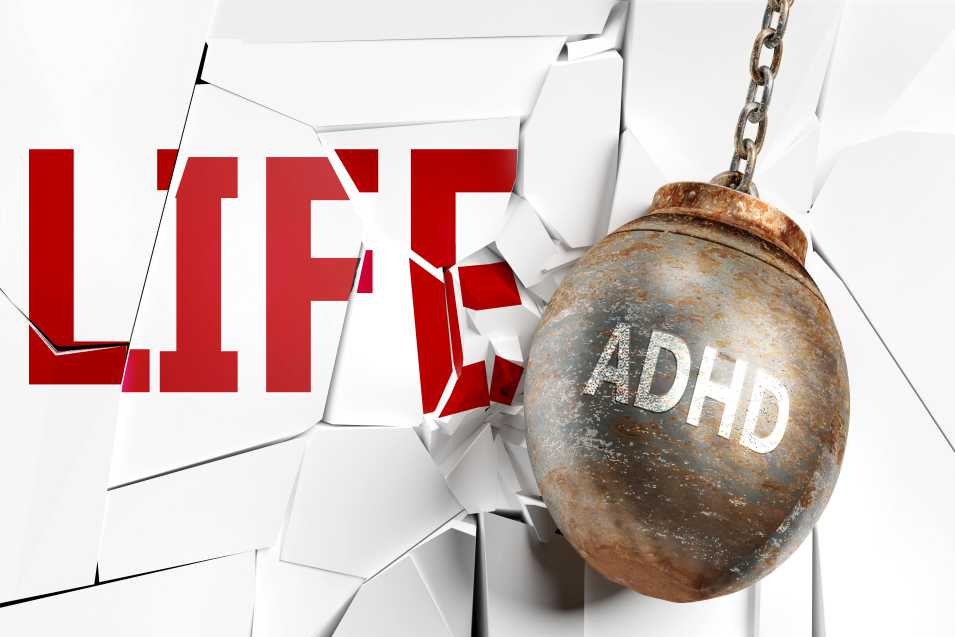
When it comes to understanding the complex dynamics of ADHD (Attention-Deficit/Hyperactivity Disorder), one intriguing aspect that often goes unnoticed is the connection between object permanence and the challenges individuals with ADHD face. Object permanence refers to the ability to understand that objects continue to exist even when they are out of sight. In this article, we will delve into the invisible challenge of object permanence and its impact on individuals with ADHD.
ADHD is a neurodevelopmental disorder characterized by symptoms such as inattention, hyperactivity, and impulsivity. While these symptoms are widely known, the underlying difficulties related to object permanence are often overlooked. Object permanence is a fundamental cognitive skill that develops during infancy. It enables us to comprehend that an object still exists even when it is hidden from view, an awareness that forms the basis for memory and problem-solving abilities. However, individuals with ADHD may struggle with object permanence, leading to various challenges in their daily lives.
The inability to fully grasp object permanence can manifest in different ways for people with ADHD. They may frequently misplace or forget items, causing frustration and disorganization. For example, a person with ADHD might struggle to find their keys or misplace important documents due to difficulties in retaining the awareness of where these items were last placed. This challenge can lead to increased stress and anxiety, as well as a negative impact on their productivity and overall well-being.
Moreover, the invisible nature of object permanence in relation to ADHD creates additional hurdles in social interactions. Others may perceive individuals with ADHD as forgetful or careless, without recognizing the underlying cognitive struggles they experience. This misperception can strain relationships and contribute to feelings of isolation and self-doubt.
Addressing the invisible challenge of object permanence in individuals with ADHD requires a multifaceted approach. Strategies such as creating consistent routines, implementing organizational systems, and using visual reminders can significantly enhance their ability to retain object permanence. Additionally, mindfulness techniques and cognitive-behavioral therapies tailored for individuals with ADHD can help improve attention and memory skills.
Unraveling the Mystery: Exploring the Link Between Object Permanence and ADHD
When it comes to understanding attention deficit hyperactivity disorder (ADHD), researchers have delved into various aspects of cognitive development. One intriguing area of exploration is the potential connection between object permanence and ADHD. In this article, we will shed light on this fascinating link and explore its implications.
Object permanence refers to a child's ability to understand that objects continue to exist even when they are out of sight. It is a crucial milestone in cognitive development, usually achieved around the age of 8 months. However, some studies suggest that children with ADHD may struggle with this aspect of perception.
Research has shown that there might be a correlation between deficits in object permanence and ADHD symptoms. Children diagnosed with ADHD often exhibit difficulties with sustained attention, impulse control, and working memory. These challenges can affect their ability to maintain mental representations of objects when they are no longer visible.
The lack of object permanence skills may contribute to the distractibility commonly observed in individuals with ADHD. Without a solid understanding of an object's continued existence, individuals may struggle to stay focused on tasks or instructions. They may become easily sidetracked by new stimuli in their environment, leading to reduced productivity and increased impulsivity.
Moreover, impaired object permanence could impact academic performance. Tasks that require holding information in mind, such as reading comprehension or solving complex math problems, may pose greater challenges for individuals who struggle with object permanence. Difficulties in organizing thoughts and retaining information can hinder learning and contribute to academic underachievement.
Understanding the link between object permanence and ADHD is crucial for improving interventions and support for individuals with ADHD. By addressing deficits in object permanence through targeted interventions, it may be possible to enhance attentional abilities, impulse control, and overall cognitive functioning.
the relationship between object permanence and ADHD is a captivating puzzle that researchers continue to unravel. The potential connection between deficits in object permanence and the symptoms of ADHD highlights the importance of considering cognitive development in understanding and treating this disorder. By exploring this link further, we can gain valuable insights into how to better support individuals with ADHD and improve their quality of life.
Hidden Obstacles: How ADHD Affects Perception of Object Permanence
ADHD, dikkat eksikliği ve hiperaktivite bozukluğu olarak bilinen bir nörolojik durumdur. Bu durum, bireylerin odaklanma, planlama yapma ve davranışlarını kontrol etme yeteneklerini etkileyebilir. Ancak, ADHD'nin sadece bu alanları etkilemediği bilinmektedir. Son araştırmalar, ADHD'nin nesne sürekliliği algısı üzerinde de önemli bir etkiye sahip olduğunu göstermektedir.
Nesne sürekliliği, bir nesnenin görüş açısında kaybolmasına rağmen varlığının hala devam ettiği fikrini anlamayı içerir. Örneğin, bir oyuncak koli masanın arkasına gizlendiğinde, çoğumuz oyuncağın orada olduğunu ve sadece gözden uzak olduğunu anlayabiliriz. Ancak, ADHD olan bireylerde bu algısal beceri zorluklarla karşılaşabilir.
ADHD'li bireyler, nesnelerin sürekli bir varoluşa sahip olmadığını düşünebilirler. Oyuncak kolinin masanın arkasında olduğunu anlamakta güçlük çekebilirler veya onu tamamen unutabilirler. Bu durum, çocukların oyun sırasında nesneleri takip etme veya bulma becerilerini olumsuz yönde etkileyebilir. Aynı şekilde, yetişkinlerde de bu zorluklar ortaya çıkabilir ve günlük aktiviteleri etkileyebilir.
ADHD'nin nesne sürekliliği üzerindeki etkisi, bireyin dikkat dağıtıcı uyaranlara odaklanma eğiliminden kaynaklanabilir. ADHD'li bireylerin zihinleri genellikle hızlıca hareket eder ve ilgileri kolayca dağılır. Bu durum, nesnenin devamlılığına ilişkin farkındalığı azaltabilir ve algılamayı olumsuz etkileyebilir.
Bu gizli engel, ADHD olan bireylerin günlük yaşamda karşılaştıkları pratik sorunları anlamada önemlidir. Özellikle eğitim ve öğrenme süreçleri sırasında çocuklar için zorluklar yaratabilir. Bu nedenle, ADHD'nin nesne sürekliliği algısını nasıl etkilediğini anlamak ve buna uygun destek sağlamak, bireylerin daha iyi başarılara ulaşmasına yardımcı olabilir.
ADHD'nin sadece dikkat eksikliği ve hiperaktiviteyle sınırlı olmadığını görmekteyiz. Nesne sürekliliği algısı üzerindeki etkisi, bireylerin nesnelerin varlığına ilişkin farkındalıklarını zorlaştırabilir. Bu gizli engeli anlamak ve uygun destek sağlamak, ADHD'li bireylerin yaşam kalitesini artırabilir ve günlük aktivitelerde daha iyi bir performans göstermelerine yardımcı olabilir.
The Invisible Challenge: Understanding the Connection Between Object Permanence and ADHD
Have you ever wondered about the invisible challenges that individuals with Attention-Deficit/Hyperactivity Disorder (ADHD) face? One such challenge is understanding object permanence. In this article, we will delve into the intriguing link between object permanence and ADHD, shedding light on how it impacts the lives of those with the condition.
Object permanence refers to the cognitive ability to understand that objects continue to exist even when they are out of sight. This concept develops during infancy and plays a significant role in cognitive development. However, studies have shown that individuals with ADHD may struggle with object permanence beyond childhood, leading to various difficulties in their daily lives.
One area where the impact of impaired object permanence becomes apparent is organization and time management. Individuals with ADHD often struggle to keep track of their belongings and frequently misplace items. This challenge can be frustrating and time-consuming, affecting their productivity and overall well-being.
Furthermore, impaired object permanence can affect attention and focus. Those with ADHD may find it difficult to sustain attention on tasks and may become easily distracted by environmental stimuli. The inability to mentally visualize the location of objects or remember where they were last seen can contribute to this distractibility, making it harder for individuals with ADHD to concentrate and complete tasks efficiently.
Additionally, impaired object permanence can influence social interactions. People with ADHD may encounter challenges in maintaining relationships as they struggle to keep track of details, such as names, faces, and conversations. This can lead to misunderstandings and difficulties in bonding with others, potentially impacting their social and emotional well-being.
Understanding the connection between object permanence and ADHD is crucial in developing effective strategies to support individuals with the condition. By implementing organizational techniques, such as creating designated spaces for belongings and using visual reminders, individuals with ADHD can improve their object permanence skills and enhance their daily functioning.
the invisible challenge of impaired object permanence has a significant impact on individuals with ADHD. By recognizing and addressing this issue, we can provide better support and empower those affected by ADHD to overcome their challenges and thrive in various aspects of their lives. Let us strive towards a more comprehensive understanding of ADHD, ensuring that no one faces these invisible challenges alone.
ADHD and Object Permanence: Bridging the Gap in Cognitive Development
Attention Deficit Hyperactivity Disorder (ADHD) is a neurodevelopmental condition that affects both children and adults, causing difficulties in attention, hyperactivity, and impulsivity. While ADHD is commonly associated with these core symptoms, recent studies have shed light on its potential impact on cognitive development, particularly in relation to object permanence.
Object permanence refers to an individual's understanding that objects continue to exist even when they are no longer visible or present. It is a crucial milestone in cognitive development, laying the foundation for more complex cognitive skills such as problem-solving and memory formation. However, individuals with ADHD often struggle with this aspect of cognition, presenting challenges in their overall cognitive functioning.
Research has shown that individuals with ADHD may exhibit delays or deficits in acquiring object permanence compared to their neurotypical peers. This discrepancy can manifest in various ways, such as difficulties in finding misplaced objects, forgetfulness, or problems with organizing and planning. These struggles can be attributed to the underlying executive function impairments commonly seen in ADHD, including working memory deficits and poor attentional control.
Understanding the link between ADHD and object permanence is crucial for developing effective interventions and support strategies. By recognizing the specific cognitive challenges faced by individuals with ADHD, educators, parents, and clinicians can tailor their approaches to better address their needs. Interventions that focus on enhancing executive functions, working memory training, and improving attentional abilities have shown promise in bridging the gap in cognitive development for individuals with ADHD.
Moreover, helping individuals with ADHD develop compensatory strategies and organizational skills can also contribute to improving their object permanence abilities. Utilizing visual aids, creating consistent routines, and implementing reminders can assist individuals with ADHD in internalizing the concept of object permanence and applying it in their daily lives.
